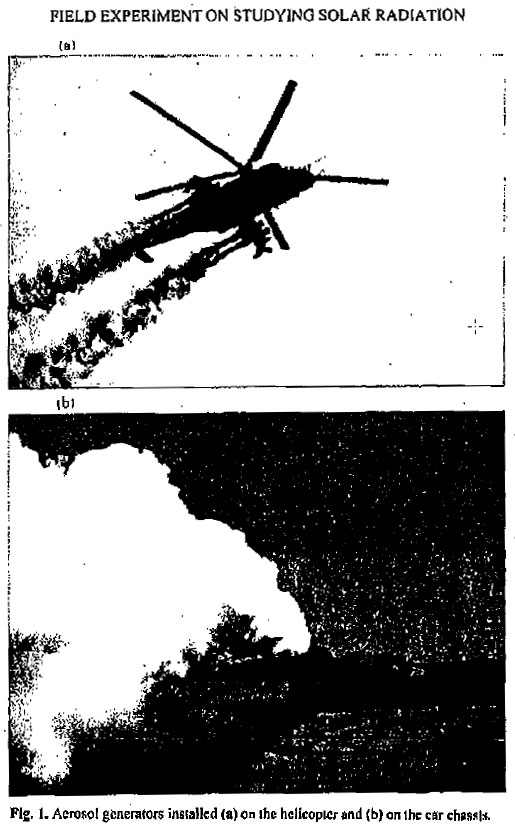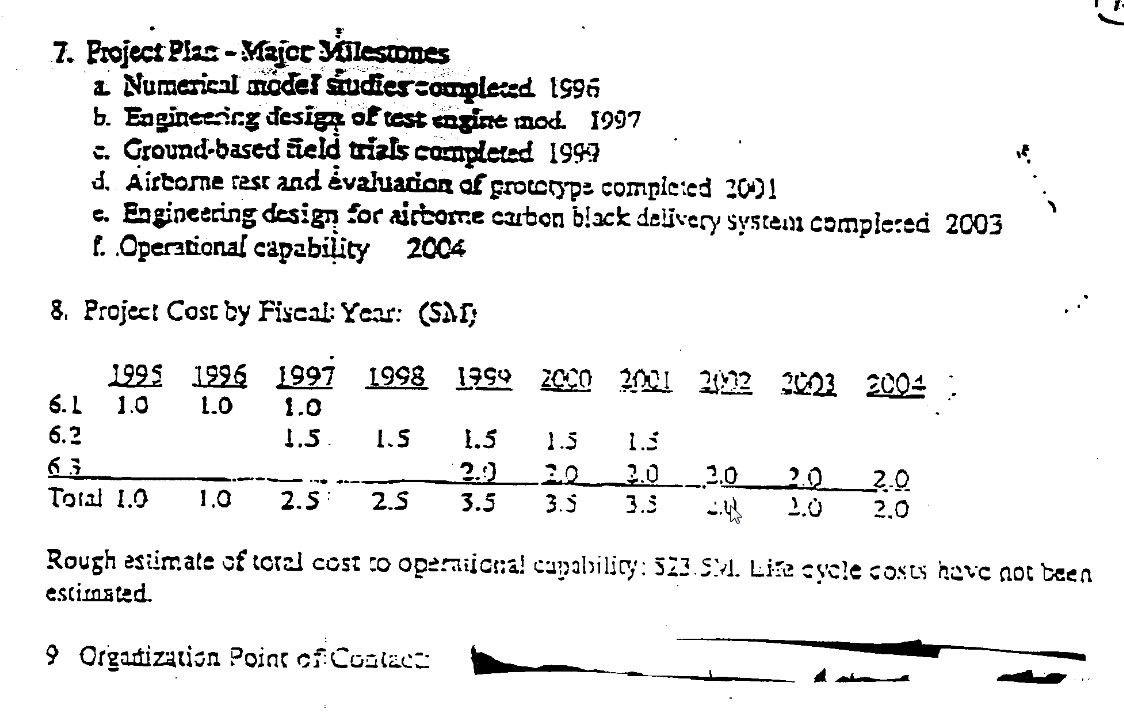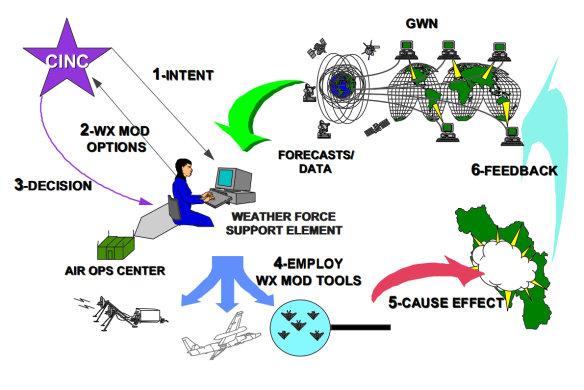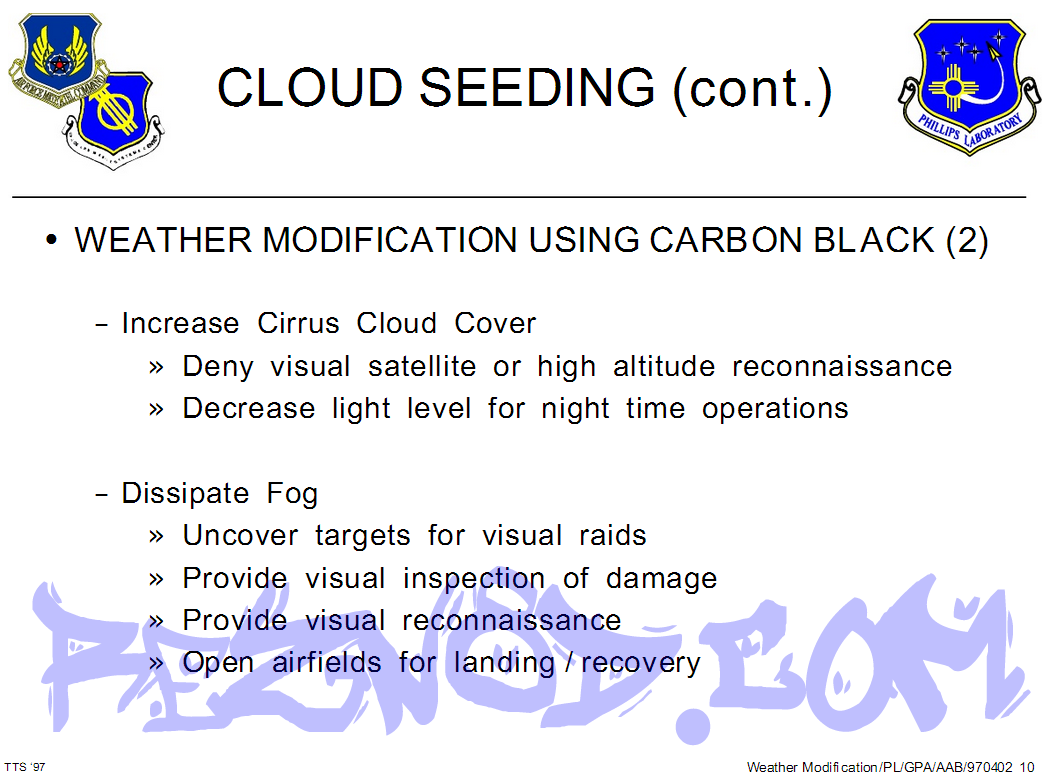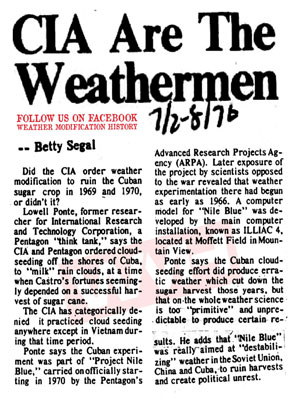
This article will prove beyond a shadow of a doubt that the contrails we see over our heads every day is an on-going geoengineering project, who is involved, and why they claim they are screwing with our sky! Every quote has references, every fact has been triple checked, and the case is closed: Contrail-induced Cirrus clouds are the New Manhattan Project, the world’s biggest in-your-face experiment. Please check the facts in this article, verify the material, and add to our ever-growing list of evidence. Let us begin.
If you read my last article The CIA, Weather Warfare, and Climate Terrorism or watched the video on YouTube then you know that even the CIA is freaking out about “who is controlling our weather?” The fact is nobody really knows and there is no way to tell! Scientists barely understand how aerosols form clouds, cannot predict the outcome of cloud seeding experiments after 60 years of performing them, and their atmospheric sensors cannot tell the difference between natural weather and man-made weather.
Dr. Cush Ngonzo Luwesi (PhD) from Nairobi had a great response to Alan Robock’s CIA revelations:
This is quite obvious Prof. Spy agencies and state criminals have long used unconventional arms to harm other people or countries, whether in time of war or peace. As a genuine scientist, your worries are also quite genuine. I am quite sure that some of your fellow researchers are receiving such funds to develop climate intervention technologies that will be used for other purposes than fixing the global warming issue. I therefore urge you to keep up raising awareness on these issues.I fully agree that the military will be the real winner if geoengineering SRM becomes legal, nonetheless scientists press on with their research swearing the military has nothing to do with their work:
As for the U.S. Department of Defense — forget about it. To this group, such involvement prompts nightmares of a new military-industrial-geoengineering complex. One novel solution: demand that all technology used for sunlight reduction technologies remain in the public domain. “The issue is not private investment,” argued Keith. “It’s is open intellectual property.” Open-source climate engineering, anyone?Lesson five: Trust is everything. The media loves to play up the angle of hubristic geoengineers hell-bent on messing with a system they don’t understand, but there was very little bold or reckless talk at Asilomar. The entire mood of the meeting was somber and hyper-alert to the dangers that lay ahead. “The whole game,” David Victor pointed out, “is about establishing credibility.” In other words, if the public comes to see geoengineering as, as one attendee put it, “a crazy idea cooked up by rich Anglo Saxons to dominate the climate,” then they will all be rightfully tarred and feathered.
Geoengineering scientists claim their work is just a bunch of computer models and theories but we know that is not true, they are already experimenting in our skies with Geoengineering Solar Radiation Management and we can prove it.
Official List of Geoengineering SRM Field Experiments
Here is the official list of geoengineering field projects posted on the Geoengineering Our Climate blog:#1 - Field Experiment on Studying Solar Radiation Passing through Aerosol Layers, Izrael et al 2009
Yuri Izrael’s solar radiation experiment carried out in Russia with an uncertain degree of scientific credibility and an unclear assessment process;Results of a field experiment on studying solar radiation passing in the visible wavelength range are described with the model aerosol media created in the surface atmosphere. High-efficiency thermocondensation generators were used for creating model aerosol media. The index of refraction and an average size of the aerosol particles formed are close to those characteristic of the natural stratospheric aerosol. The composition and technical characteristics of the equipment complex used in the experiments to control aerosol optical and microphysical parameters and meteorological conditions of the experiment are considered. The Gaussian model of impurity dispersion in the boundary layer is used for the analysis and interpretation of measurement results. It is found that with a number concentration of aerosol particles of ∼102–103 cm−3 (which corresponds to the aerosol density in the deposited layer of about 1–10 mg/m2 with the layer thickness along the ray path of about 100 m) the solar radiation attenuation with artificial aerosol layers accounts for 1 to 10%. Model estimates are in satisfactory agreement with the measurement results.
Original Russian Text © Yu.A. Izrael, V.M. Zakharov, N.N. Petrov, A.G. Ryaboshapko, V.N. Ivanov, A.V. Savchenko, Yu.V. Andreev, Yu.A. Puzov, B.G. Danelyan, V.P. Kulyapin, 2009, published in Meteorologiya i Gidrologiya, 2009, No. 5, pp. 5–15.
- Russian Mi-24 Hind helicopter with aerosol generators burning "metal-chloride pyrotechnic compounds"
- Car with a smoke generator burning oils and gas: "as a result of condensation of overheated vapor-gas mixture of individual fractions of petroleum products released at a high rate."

#2 E-PEACE Eastern Pacific Emitted Aerosol Cloud Experiment, July-August 2011
E-PEACE, an experiment which while not identifying as SRM resulted in clear implications for marine cloud brightening (MCB) technology post hoc;E-PEACE combined a targeted aircraft campaign off the coast of Monterey in July and August 2011 with embedded ship and satellite observations (Fig. 2) and modeling studies. Atmospheric conditions in the northeastern Pacific during July are ideal for the formation of homogeneous layers of persistent stratocumulus clouds. The layers observed have consistent diurnal characteristics, cloud thicknesses of 100–300 m, and cloud-top heights typically below 500 m. The susceptibility of cloud albedo to particle perturbations is well documented for the eastern Pacific near 36°N (Coakley et al. 1987, 2000; Platnick et al. 2000).We employed the research vessel (R/V) Point Sur to measure the aerosol below cloud and as a platform for well-characterized smoke emissions to produce a uniquely identifiable cloud signature. The Center for Interdisciplinary Remotely-Piloted Aircraft Studies (CIRPAS) Twin Otter aircraft was used with a full payload of instruments (Table 3) to measure particle and cloud droplet number, mass, and composition. E-PEACE combined 1) controlled release of smoke from the deck of the Point Sur, salt aerosol from the Twin Otter, and exhaust from container ships transiting across the study region; 2) flight plans designed to investigate results from large-eddy simulations (LES) and to provide constraints for aerosol–cloud parcel (ACP) modeling studies, to test our ability to quantitatively predict the cloud dynamical response to increases in particle concentrations in the natural atmosphere; and 3) satellite analyses of marine stratocumulus to constrain the radiative properties of the natural, perturbed, and regional cloud systems.
With 12 days of ship time on the R/V Point Sur and 30 flights (each ~4.5 h long) on the CIRPAS Twin Otter (Tables 4 and 5), we could take full advantage of the persistence of stratocumulus clouds to probe the effect of particle sources on marine stratocumulus properties. Since the particles would be emitted in high concentrations over small areas in crosswind directions, their effects on clouds could be separated from those of meteorology. And in terms of number concentration and duration, the impacts of these particle emissions would be large enough to be distinguished from natural cloud variability.
As noted above, three types of particles were involved in E-PEACE:
- combustion exhaust particles from cargo ships of opportunity, which are the emissions responsible for ship tracks;
- shipboard smoke-generated particles; and
- aircraft-based milled salt particles (Fig. 3).
Type 1 is the exhaust that consists of 50–100-nm dry-diameter particlesemitted at rates of 1016–1018 s–1 from the engines of large (2,000 ton) cargo ships, in this instance on trans-Pacific, Los Angeles to San Francisco, or other commercial routes. Such emissions were responsible for the first observed ship tracks (Conover 1969). At a fuel cost of about $100,000 (U.S. dollars) per day, operations of such vessels dedicated solely to research are not feasible. However, real-time tracking of commercial vessels (www.marinetraffic.com) was used to identify fast-moving (>30 km h–1) cargo or container ships in the region within the aircraft operating area (as illustrated in Fig. 4).
Type 2 involves smoke particles produced at an estimated rate of 1011–1013 s–1 on the stern deck of the R/V Point Sur (described in “Tailor-made particles with a battlefield smoke generator”), with dry diameters that ranged from 50 nm up to 1 μm and very low hygroscopicity.
Type 3 particles were dispersed from the Twin Otter aircraft in cloud. An adjustable auger fed a fluidized bed that dispensed NaCl particles, which had been milled to diameters of 3–5μm and mixed with SiO2 to prevent particles from sticking together (Drofa et al. 2010).


#3 The SPICE (Stratospheric Particle Injection for Climate Engineering) Project, 2012 [CANCELLED]
The SPICE project’s cancelled balloon deployment experiment, whose “stagegate” process was interested in exploring a wide range of SRM governance issues.A field trial for a novel UK geoengineering experiment has been cancelled amid questions about a pre-existing patent application for some of the technology involved.Was it patent or protest that killed SPICE?The Stratospheric Particle Injection for Climate Engineering (SPICE) project is a collaboration among several UK universities and Cambridge-based Marshall Aerospace to investigate the possibility of spraying particles into the stratosphere to mitigate global warming. Such particles could mimic the cooling produced by large volcanic eruptions, by reflecting sunlight before it reaches Earth’s surface.
But the field-trial arm of SPICE — which would have seen around 150 litres of water pumped into the atmosphere through a 1-kilometre hosepipe attached to a balloon — has now been abandoned.
“It is with some regret that today the SPICE team has announced we’ve decided to call off the outdoor ‘1km testbed’ experiment that was scheduled for later this year,” said Matthew Watson, the principal investigator of SPICE and an Earth scientist at the University of Bristol, UK, in an e-mail statement to Nature.
The project had attracted a forceful protest campaign from NGOs such as Friends of the Earth and ETC group. A petition signed by more than 50 organisations was handed in the same day as the decision to pause the project was announced by the EPSRC. They objected to the project in part because they feared that a “plan B” approach of engineering the climate will offer politicians an excuse for not taking tough decisions on reducing greenhouse gas emissions from burning fossil fuels such as oil, coal and gas. | Link
- How will geoengineers address the statements of the AMS, WMO, and NRC on Weather Modification? | Link
- The SPICE project: a geoengineering feasibility study | Link
- Scientists to create artificial volcano for climate change experiment | Link
- Political backlash to geoengineering begins | Link
- Scientists criticise handling of pilot project to ‘geoengineer’ climate | Link
- Demonstrating the SPICE project | Video Link
- Cooling the Planet – Naked Engineering | Video Link

Could the patent contraversy have anything to do with Bill Gates’ “Hose to the Sky” The Stratoshield from 2009?
#4 South African Cloud-Seeding Experiments Using Hygroscopic Flares, 1996
Using much larger particles than standard cloud-seeding, these salt particles made clouds, fast.While hygroscopic seeding is not new, most experiments to date have used finely ground salt particles, usually larger than about 10 mm. The disadvantages of this approach are the weight that has to be carried for any practical applications and the difficulty in handling and dispensing the highly hygroscopic and corrosive salt particles. Also, the growth rates of the salt embryos to raindrops must be matched well to the updraft profile, or their growth will be inefficient (Klazura and Todd 1978). While some positive effects have been attributed to such seeding (Biswas and Dennis 1971), the logistics of handling the hygroscopic salts have made this method less attractive than ice nuclei seeding.Dr. Stephen Salter says:The approach reported here uses easily handled pyrotechnic flares that produce small salt particles, average size around 0.5 mm, that broaden the cloud base droplet spectra thus accelerating coalescence. Our hypothesis is that this increases the efficiency of the rain formation process in treated storms. The operational advantages of this method are the amount of salt required is much less, the salt particles are readily produced by flares, the target area for seeding is an easily identified region at cloud base where the initial droplet spectrum is determined, dispersion of the material is much easier, and long-term storage of the flares presents no problems. source: Results of the South African Cloud-Seeding Experiments Using Hygroscopic Flares
Jack Doughty could also have mentioned the film made by Discovery Channel of the amazing result from cloud seeding flares off Liaaplek in South Africa. They had been told that conditions there meant that it always had perfect strato-cumulus cloud. When we arrived with a 40-person film crew, an aircraft, helicopter, ship and support vessels there was hardly a cloud in the sky. John Latham and I kept telling the producer that we were trying to make existing clouds a tiny bit whiter and that it could not possibly work with no cloud. Filming 'experts' making fools of themselves is great television so they went ahead anyway and lit up the flares. My very rough engineering estimate was that it was about two minutes of the output of a spray vessel.The result was stunning. It created a very white cloud from nothing, about 5 km by 1.5 km. At that time of day the cloud top would be reflecting about 800 watts per square metre over an area of about 7.5 million square metres which I make to be 6 GW, more than the peak electrical demand of Scotland. It spread out slowly but was still visible about two hours later.
The air mass must have been extremely clean. Perhaps it had been over Antarctica for months. A picture should be below.
The heavens did not fall and nobody went to jail. source: Dr. Stephen Salter
But wait, there's more...
Wait, that can't be the full list of solar radiation management field experiments?How could they not mention the artificial clouds or ship tracks?
Pay attention policy makers, the contrail con-game is over:
Geoengineering SRM Experiments using Contrails
Scientists claim that contrail cirrus has nothing to do with Geoengineering SRM experiments when in fact "contrail-induced cirrus clouds" are the longest-running SRM field experiment.
Those who do not remember the past are doomed to repeat it.
At the end of Sheila’s video (above) we see video testimonial from the victims of U.S. human testing back in the 50’s and 60’s. The U.S. military does not care about the law when “national security” is concerned. The Council on Foreign Relations’ “Climate Change and National Security, An Agenda for Action” from 2007 pretty much sums it up. In the name of “continuity of government” our three letter agencies and military branches are already geoengineering our skies with contrails. My belief is that through the alteration of fuel sulfur content and additives to increase carbon black soot production U.S. “agencies” are increasing cloudiness worldwide, testing the results, and revising their “strategies” daily in this grand “New Manhattan Project.”
For those who doubt the US military’s intention to control climate chaos, the following two 1994 FOIA documents obtained by The Sunshine Project show both the US Air Force and US Navy are engaged in weather modification techniques.
- US Air Force proposal to develop a theater-scale weather modification system using carbon black.Phillips Laboratory (AFMC) Geophysics DirectorateReleased under 1994 FOIA from the Joint Non-Lethal Weapons Directorate.
- US Navy proposal to develop new weather modification weapons.Code C2741 (Warhead Development Branch) NAWCWPNS, China Lake, California.This proposal is from April, 1994 and was submitted to the Joint Non-Lethal Weapons Directorate.

The Navy paper above proposes studying weather control under the name “non-lethal warfare” and the paper below shows a timeline of the US Air Force Phillips Lab’s use of carbon black aerosols.
After the 1994 proposals mentioned in the FOIA documents, weather warfare techniques were researched in detail with Air Force 2025.
In December 1994, the Chief of Staff of the United States Air Force (CSAF) tasked Air University to conduct a study to identify the concepts, capabilities and technologies the United States would require to remain the dominant air and space force beyond the first quarter of the 21st century. The study was called Air Force 2025, or 2025for short. USAF 2025 Fact SheetAs a part of AF 2025, the United States Air Force discussed the future of weather warfare in its 1995-1996 brainstorming session “Weather as a Force Multiplier; Owning the Weather in 2025: Weather as a Force Multiplier.” Of particular interest is the following chart which shows the use of “Carbon Black Dust (CBD)” by 2005 with a star indicating “Technologies to be developed by the Department of Defense.”
Also worthy of mention is the intent to create a global weather control system, see the following images (WXMOD is military jargon for “weather modification”):
The intention to dominate the climate for weather warfare is clear.
Owning the Weather Meets Reality
Weather warfare, as laid out in the “Owning the Weather in 2025″ paper, was presented the following year at a joint US Air Force and US Army conference titled “Test Technology Symposium ’97 Weather Modification.” The presenter, Dr. Arnold Barnes from the Phillips Lab/GPO at Hanscom Air Force Base, reiterated the use of Carbon Black Dust for weather modification and showed a slide with “Current Capabilities” as of 1997.
- MAJOR IMPROVEMENTS IN SHORT TERM FORECASTS BY 2010
- 14 DAY FORECASTS BY 2040
- CURRENT CAPABILITIES (1997)
1. TARGETED FOG DISPERSAL
2. LOCAL CHANGES IN PRECIPITATION 3. CLOUD MODIFICATION
- SURVEILLANCE/COVERAGE
- HOLE BORING
- CREATE/SUPPRESS CIRRUS/CONTRAILS
- ENERGY REQUIREMENTS TOO LARGE FOR MAJOR STORMS
- TREATY RESTRICTIONS
- NEW WEAPON SYSTEMS PUSH THE ENVELOPETHE ENVIRONMENT MUST BE CONSIDERED FROM THE START OF THE CONCEPT/DESIGN FOR ALL NEW WEAPON SYSTEMS
Notes: Improvements in forecasts will follow from better and faster computers, improved communications and more detailed atmospheric observations from satellites, UAVs, microchips and ground based remote sensing. Current techniques for small area, short term atmospheric modifications will become easier to implement and will have improved accuracy as to the predicted results. Modifications of storms of thunderstorm size and larger are unlikely because of the energy required, the unknown side effects, and possible treaty violations. Due to political environmental concerns, it is doubtful that the treaty will be weakened. It is more likely to be made more restrictive with the growth of population and water demands. As weapons and other systems become more sophisticated, the atmospheric environment will continue to be a major factor in the usefulness and operational effectiveness of these systems. For this reason it is imperative that atmospheric scientists be brought in at the beginning on any and all new proposed systems so as to avoid the costs of altering or abandoning the system at a later date.

According to these documents, the US Air Force has had the ability to create or remove cirrus clouds and contrails since 1997 and intends to control the weather using Carbon Black dust by 2005, the year of the Katrina Hurricane disaster.
Clearly the U.S. military is involved in weather control and creating artificial clouds, yet the cover-up continues.
Masked under the guise of “climate change” studies, scientists are testing these man-made clouds and the aerosols that made them.
Carbon black dust is an “aerosol” and is also considered a “Cloud Condensation Nuclei” or CCN. Droplets of water will attach to these tiny CCN particles and form larger and larger drops of water which will eventually freeze and turn into ice or fall in the form of rain. This theory is the basis of all cloud-seeding projects today:
The exhaust plumes of jet engines predominately contain:
- Water vapor
- Sulfuric Acid - cools the planet, like Mount Pinatubo
- Carbon Black dust (soot) - heats the planet, traps heat like a black paint job on a car.
- all the other trace elements
Despite years of research on carbon black dust and weather modification, scientists still claim ignorance of the processes of Cloud Condensation Nuclei.
William M. Gray, William M. Frank, Myron L. Corrin, and Charles A. Stokes
Atmospheric Science Department, Colorado State University, Ft. Collins 80523
Climate change and geoengineering computer models do not properly account for aerosols making them the biggest unknown in atmospheric science, allegedly:
Aerosol-cloud interactions are one of the main uncertainties in climate research. Up to now a lot of research has been conducted on aerosol-cloud interactions in warm clouds. The impact of aerosols on ice or mixed-phase clouds is much less understood. Cirrus clouds in an unpolluted environment are assumed to form mainly via homogeneous freezing. The presence of heterogeneous ice nuclei can lead to earlier ice crystal formation and change the microphysical properties of cirrus clouds. Recent box model studies even suggest that heterogeneous freezing can suppress homogeneous freezing, if several conditions are fulfilled. Most likely this would lead to cirrus clouds containing fewer and larger ice crystals. If homogeneous and heterogeneous freezing compete either freezing mechanism may dominate depending mainly on vertical velocity and number density of ice nuclei. Thus, it is not clear yet how number and size of ice crystals are affected. source: Dust ice nuclei effects on cirrus clouds in ECHAM5-HAM, 2013The main reason there is so much uncertainty surrounding aerosols is atmospheric sensors are not accurate enough. Detection, modeling, and prediction of atmospheric aerosols behavior is an essential part of any Geoengineering SRM scheme, as verification is important but currently impossible. The following slide is from a NASA presentation at the Keck Institute for Space Studies (KISS) project: Monitoring of Geoengineering Effects and their Natural and Anthropogenic Analogues shows space-based instruments capable of detecting aerosols past, present, and future.
These insufficient instruments feed data into incomplete models, which are turned into reports to the IPCC et al.
Did you know that Geoengineering SRM advocates advised the IPCC on contrails and aerosols?
IPCC 5th Assessment, Clouds and Aerosols: Supplementary Material 2007
Coordinating Lead Authors: Olivier Boucher (France), David Randall (USA)According to these fine scientists and geoengineering dudes, we really have no clue how much sun is currently being blocked or reflected by contrails, let alone how they are formed, allegedly.Lead Authors: Paulo Artaxo (Brazil), Christopher Bretherton (USA), Graham Feingold (USA), Piers Forster (UK), Veli-Matti Kerminen (Finland), Yutaka Kondo (Japan), Hong Liao (China), Ulrike Lohmann (Switzerland), Philip Rasch (USA), S.K. Satheesh (India), Steven Sherwood (Australia), Bjorn Stevens (Germany), Xiao-Ye Zhang (China)
Contributing Authors: Govindasamy Bala (India), Nicolas Bellouin (UK), Angela Benedetti (UK), Sandrine Bony (France), Ken Caldeira (USA), Anthony Del Genio (USA), Maria Cristina Facchini (Italy), Mark Flanner (USA), Steven Ghan (USA), Claire Granier (France), Corinna Hoose (Germany), Andy Jones (UK), Makoto Koike (Japan), Ben Kravitz (USA), Benjamin Laken (Spain), Matthew Lebsock (USA), Natalie Mahowald (USA), Gunnar Myhre (Norway), Colin O’Dowd (Ireland), Alan Robock (USA), Bjørn Samset (Norway), Hauke Schmidt (Germany), Michael Schulz (Norway), Graeme Stephens (USA), Philip Stier (UK), Trude Storelvmo (USA), Dave Winker (USA), Matthew Wyant (USA)
[names in bold are Geoengineering SRM advocates]
We further assess the 90% uncertainty range to be +0.02 to +0.15 W m–2 to take into account the large uncertainties associated with spreading rate, optical depth, ice particle shape and radiative transfer. A low confidence is attached to this estimate.

The Bottom Line
The only difference between these contrail RF studies and the list of "official" geoengineering SRM field experiments is the scientists in the experiment didn't have to pay for the planes.- One experiment used a helicopter and car to make clouds
- another used planes and boats to make clouds
- one wanted to use boats and blimps to make clouds
- the last used salt flares to make clouds
Every single contrail RF study fits the definition, is a geoengineering SRM field project, and is “the project that shall not be mentioned.”
The ICAO has presenters discussing taking advantage of contrails to cool the planet, therefore, THIS IS GEOENGINEERING!
Here is the kicker: Contrails are actually trapping heat! It turns out that all those contrail cirrus clouds are cooling during the day and trapping heat at night, and the list of unknowns grows precipitously:
“Contrails formed by aircraft can evolve into cirrus clouds indistinguishable from those formed naturally. These ‘spreading contrails’ may be causing more climate warming today than all the carbon dioxide emitted by aircraft since the start of aviation.”So which is it, are they trying to cool the planet or trying to heat it up?Atmospheric science: Seeing through contrails by Olivier Boucher, Nature Climate Change 1, 24–25 (2011) doi:10.1038/nclimate1078 Published online 29 March 2011
Is this intentional or unintentional?
To Sulfur or not To Sulfur, that is the question
Camp 1: Add sulfur to jet fuel and Geoengineer the Skies
"Another technique examined was the use of commercial passenger aircraft flying at high altitudes to inject sulphate aerosols, emitted by aviation fuel, into the stratosphere." Reference link and Presentation

The Academy of Finland if far from alone in discussing how to geoengineer our planet using flight pollution.
- “Use commuter aircraft fuels doped with aerosol generators” [ref]
- “dissolved or suspended in their jet fuel and later burned with the fuel to create seeding aerosol, or (2) injected into the hot engine exhaust, which should vaporize the seeding material, allowing it to condense as aerosol in the jet contrail” [ref]
- “Options for dispersing gases from planes include the addition of sulfur to the fuel, which would release the aerosol through the exhaust system of the plane, or the attachment of a nozzle to release the sulfur from its own tank within the plane, which would be the better option.” [ref]
- “The particles may be seeded by dispersal from seeding aircraft; one exemplary technique may be via the jet fuel as suggested by prior work regarding the metallic particles. Once the tiny particles have been dispersed into the atmosphere, the particles may remain in suspension for up to one year.” [ref]
According to Keith’s calculations, if operations were begun in 2020, it would take 25,000 metric tons of sulfuric acid to cut global warming in half after one year. Once under way, the injection of sulfuric acid would proceed continuously. By 2040, 11 or so jets delivering roughly 250,000 metric tons of it each year, at an annual cost of $700 million, would be required to compensate for the increased warming caused by rising levels of carbon dioxide. By 2070, he estimates, the program would need to be injecting a bit more than a million tons per year using a fleet of a hundred aircraft.”Given that by 1990 global aviation’s “annual contribution to the atmospheric sulfur budget by aircraft of 2.E7 kg H2SO4.” [3], and that by 2010 Aviation emissions could had been up 110% compared to 1990 levels [4] it is safe to assume that by the year 2013, H2SO4 by aircraft emissions is already at the level that would be required by 2020 for a geoengineering regime. In other words: geoengineering is way ahead of schedule!
Also giving all the warnings about the side effects of geoengineering by SRM on the hydrological cycle i.e. drought and flooding; and the ecosystems in land and the ocean, such as this one by Edward Teller:
“Consider what might happen if we start by using a stratospheric aerosol to ameliorate global heating; even if it succeeds, it would not be long before we face the additional problem of ocean acidification”. [5]It is not at all shocking that we are already there [6]… in all counts… today! So, to the byline:
“Intentionally engineering Earth’s atmosphere to offset rising temperatures could be far more doable than you imagine, says David Keith. But is it a good idea?”[2]I would think the answer is clearly… NO! It is not a good idea. Specially in the case of SRM. Then, it could also be said that one of the most relevant questions about geoengineering by SRM is… how do we stop?
“So perhaps those in the GE community who are genuinely opposed to geoengineering should revise their premises and call for research into GE with the purpose of ending this ‘unintended’, but failed and still ongoing experiment.”Source: H2SO4 (SULFURIC ACID) FROM AVIATION MAY BE HIGHER TODAY THAN WHAT WOULD BE REQUIRED FOR A GEOENGINEERING REGIME IN 2020
Camp 2: Contrail Control
Jet Biofuel Enlisted For Contrail Control March 5, 2013Contrails might be a punch line in the culture these days, thanks to the imaginative folks who have rechristened them “chemtrails” and embroidered them with elaborate theories involving government and corporate misdeed.But contrails are pretty serious business for a less conspiratorial reason: scientists believe these ice clouds generated by water exhaust gases from aircraft engines could have a real impact on the climate, perhaps by cooling temperatures during the day and warming them at night.
That’s where a new phase in an ongoing NASA study comes into play:
The space agency recently began doing flights over the Southern California desert in which a DC-8 “flying laboratory” is testing the contrail consequences of using standard JP-8 jet fuel versus a 50-50 blend of JP-8 and a biofuel made from camelina plants.
November 30 – December 1, 2011 in Washington,DC
Dan Bulzan, NASA Glenn Research Center
- Aviation Climate Change Research Initiative (ACCRI)
- Alternative Fuel Effects on Contrails and Cruise Emissions II (ACCESS II)
- Civil Aircraft for the Regular Investigation of the atmosphere Based on an Instrument Container (CARIBIC)
- Project REACT4C “Reducing Emissions from Aviation by Changing Trajectories for the benefit of Climate” REACT4C on CORDIS
- Centre for Aviation Transport and the Environment (Omega)
- Ice-Supersaturated Regions (ISSR)
- Formation flying civilian airliners? Flying planes like birds to save on the gas bill, no joke.
- Climate compatible Air Transport System (CATS)
- Climate Optimized Routing of Flights
- Next Generation Air Transportation System (NextGen)
Experiments on Contrails:
- International Cirrus Experiment, 1987-1993 Participants: France, Germany, United Kingdom
- SUbsonic aircraft: Contrail & Clouds Effects Special Study (SUCCESS) 1996
"We plan to better determine the radiative properties of cirrus clouds and of contrails so that satellite observations can better determine their impact on Earth's radiation budget. We hope to determine how cirrus clouds form, whether the exhaust from subsonic aircraft presently affects the formation of cirrus clouds, and if the exhaust does affect the clouds whether the changes induced are of climatological significance. We seek to pave the way for future studies by developing and testing several new instruments. We also plan to better determine the characteristics of gaseous and particulate exhaust products from subsonic aircraft and their evolution in the region near the aircraft."
![SUbsonic aircraft: Contrail & Cloud Effects Special Study SUCCESS]()
- In Situ Observations of Particles in Jet Aircraft Exhausts and Contrails for Different Sulfur-containing Fuels, 1996
- Global Warming and Ice Ages – Prospects for Physics-Based Modulation of Global Change, Edward Teller, Lowell Wood, Roderick Hyde. 1997
"We expect that introduction of scattering-optimized alumina particles into the stratosphere may well be overall competitive with use of sulfur oxides; alumina particles offer a distinctly different environmental impact profile."
- First Direct Sulfuric Acid Detection in the Exhaust Plume of a Jet Aircraft in Flight, 1998
- Dilution of Aircraft Exhaust Plumes at Cruise Altitudes, 1998
- Long-Range Weather Prediction And Prevention of Climate Catastrophes – A Status Report. Edward Teller, Lowell Wood, Roderick Hyde. 1999
- Ultrafine Particle Size Distributions Measured in Aircraft Exhaust Plumes, 2000
- In Vitro Toxicity of Aluminum Nanoparticles in Rat Alveolar Macrophages, 2001
- Regional Variations in U.S. Diurnal Temperature Range for the 11–14 September 2001 Aircraft Groundings: Evidence of Jet Contrail Influence on Climate, 2004
- Active Climate Stabilization – Practical Physics-Based Approaches to Prevention of Climate Change. Edward Teller, Lowell Wood, Roderick Hyde.
- Particles and Cirrus Clouds (PAZI-2) Final Report, 2004
- ATM Contrail Mitigation Options Environmental Study 2005




